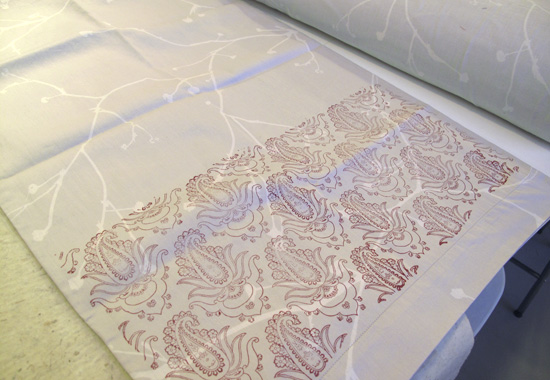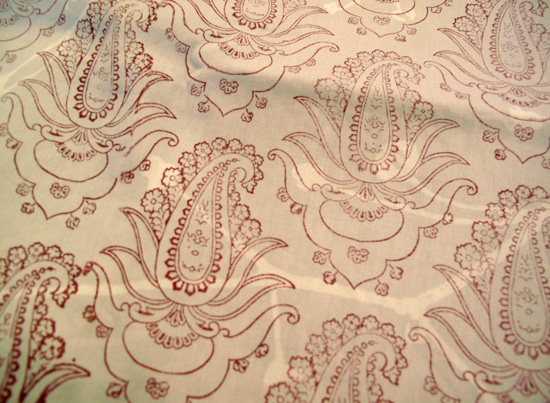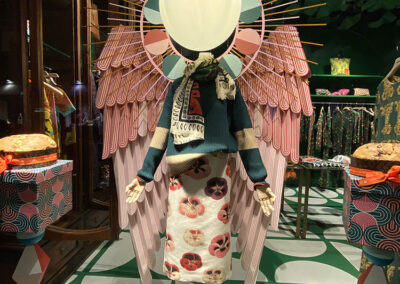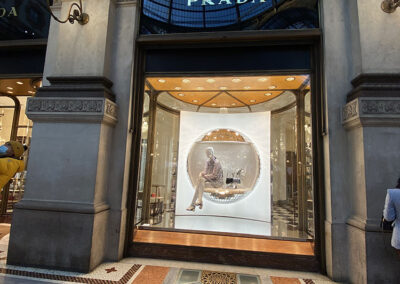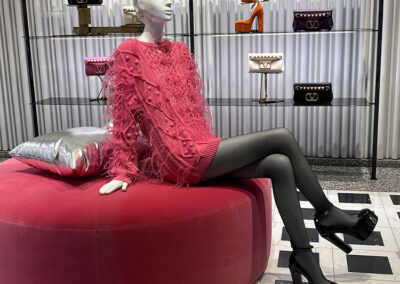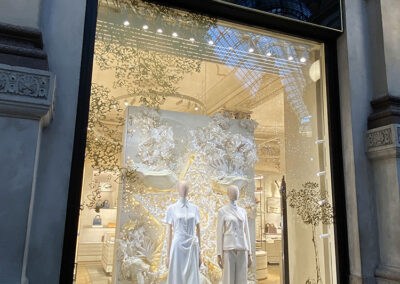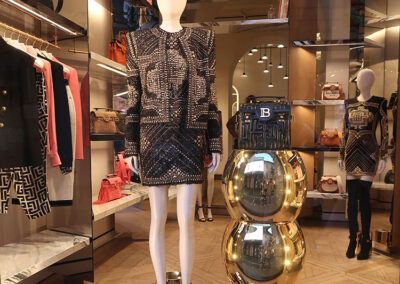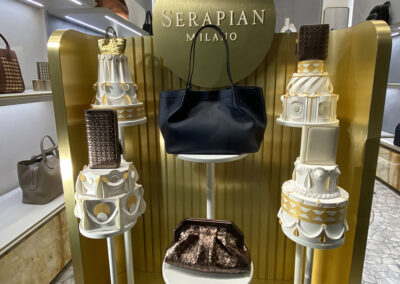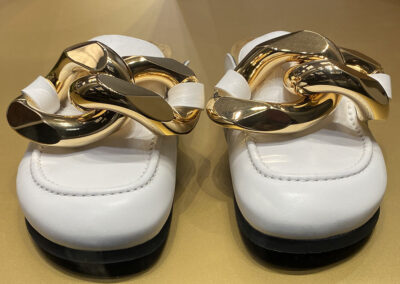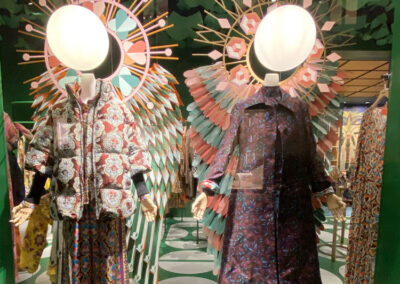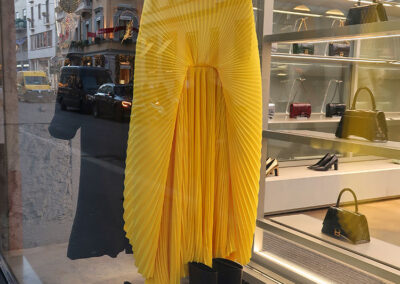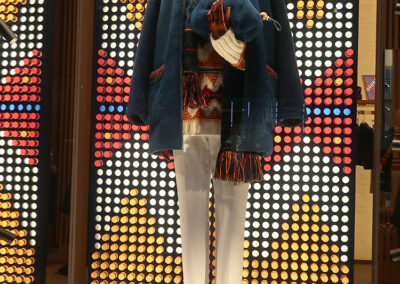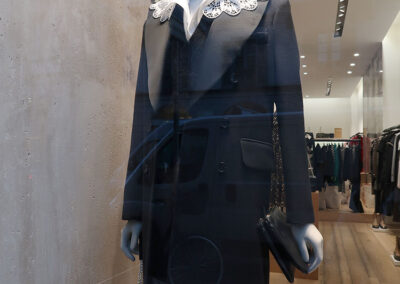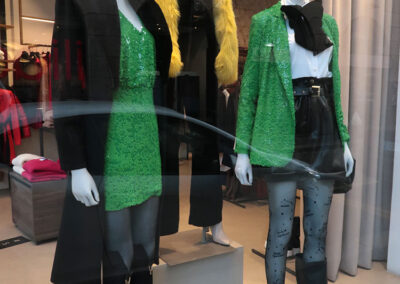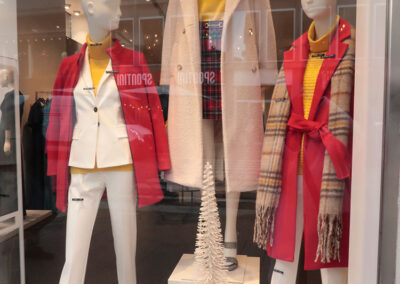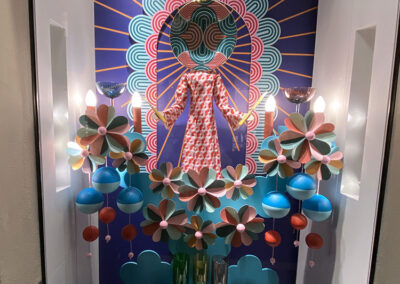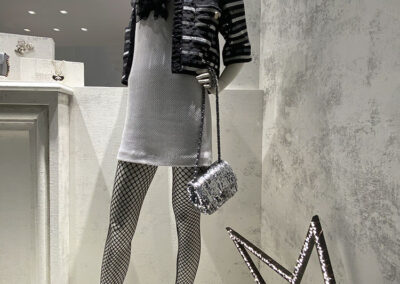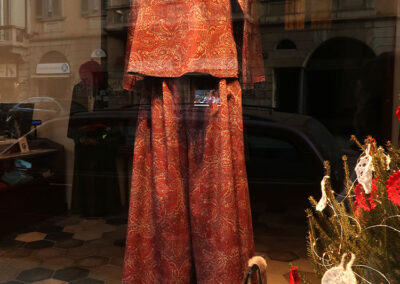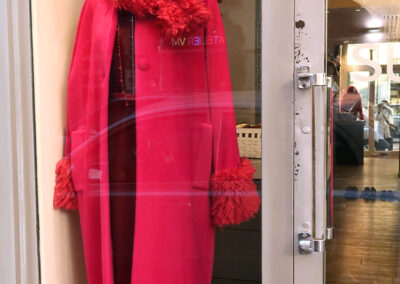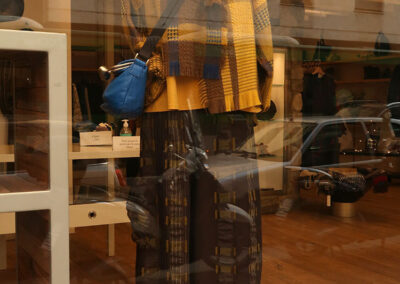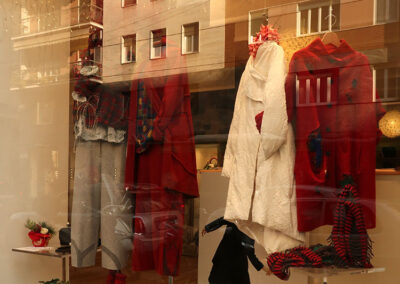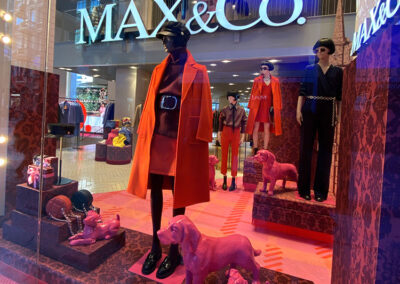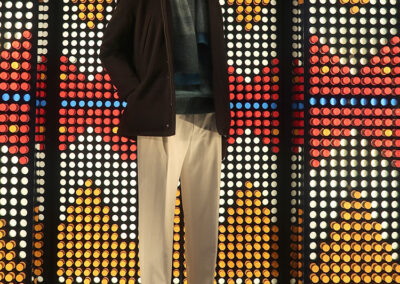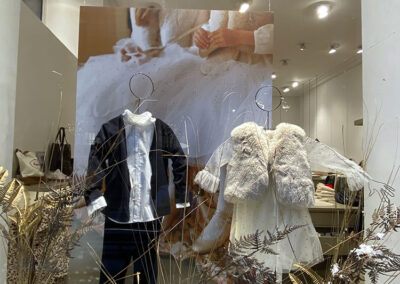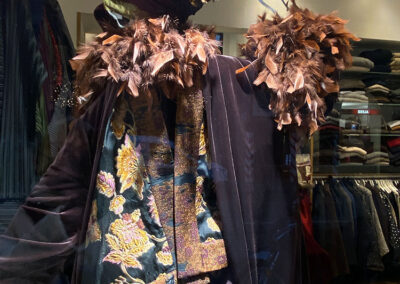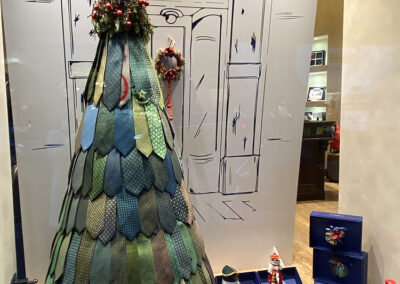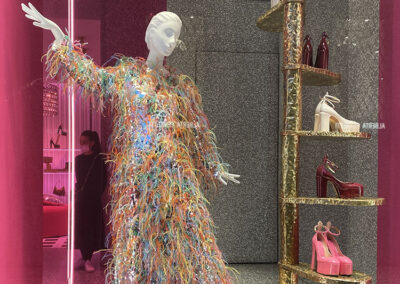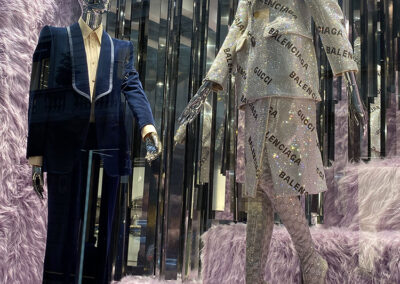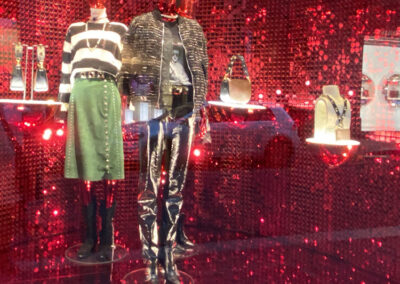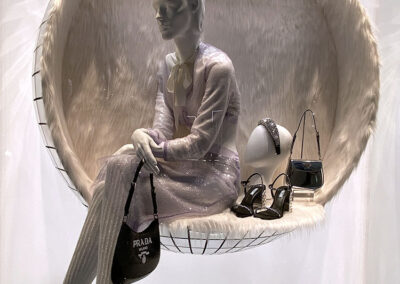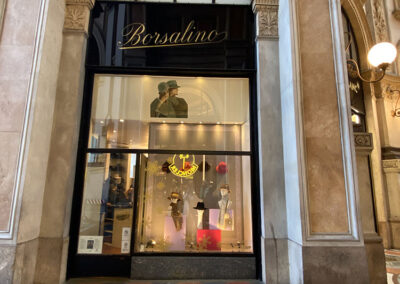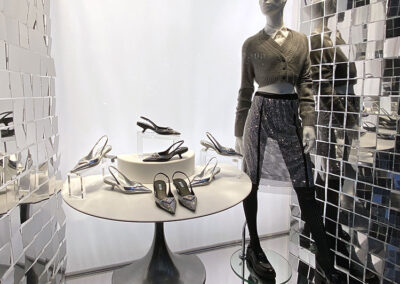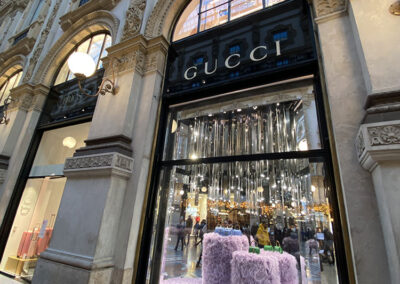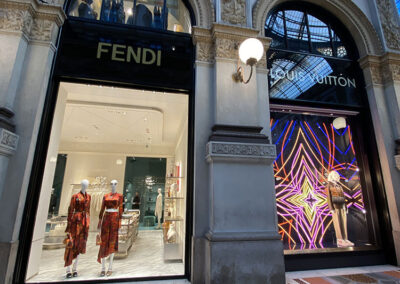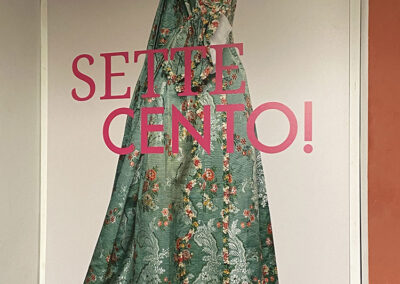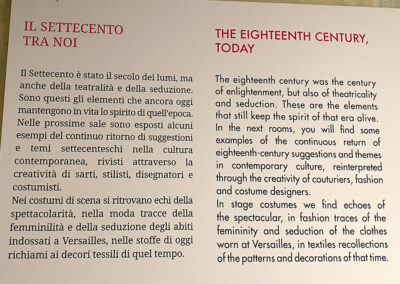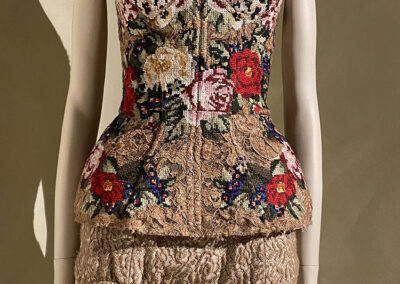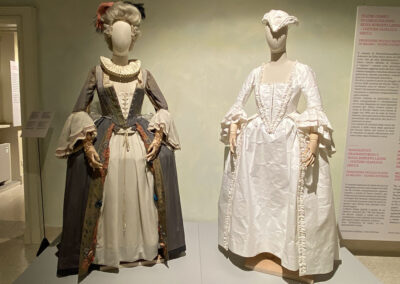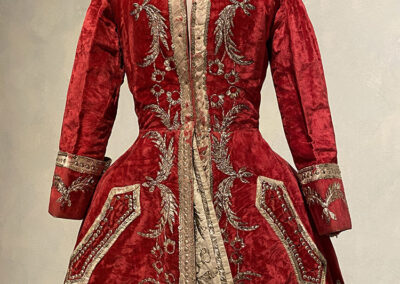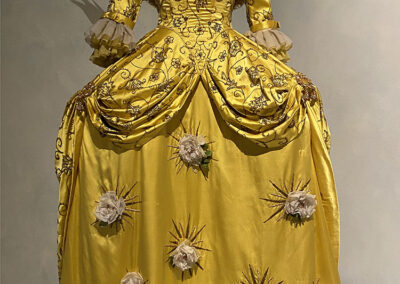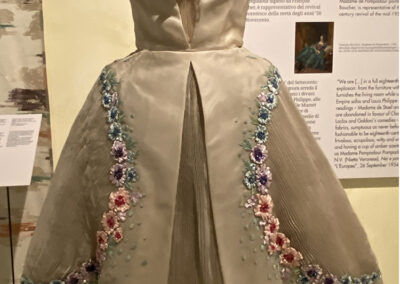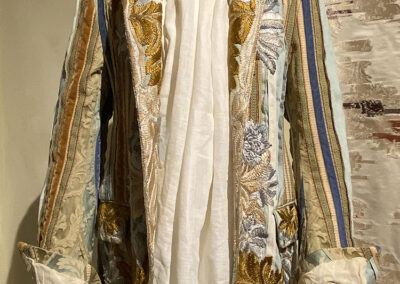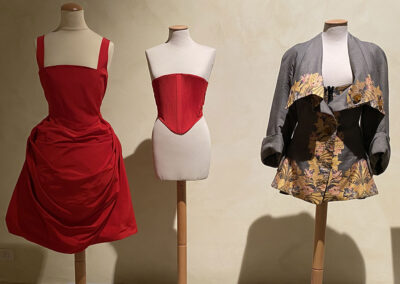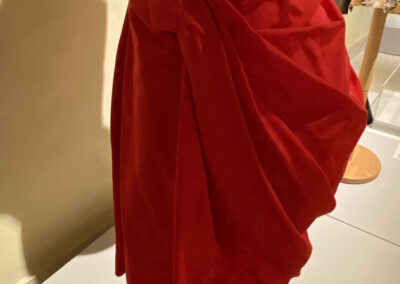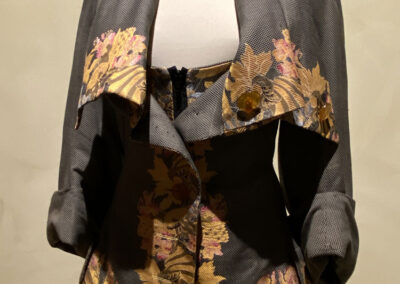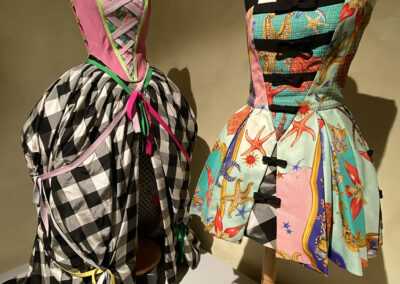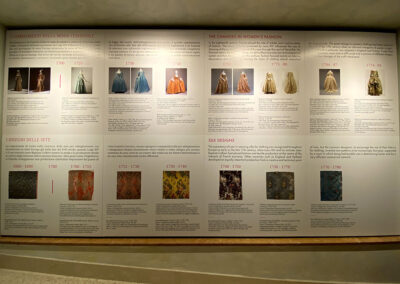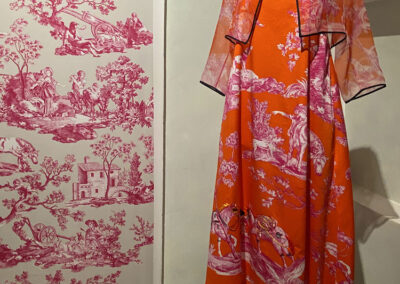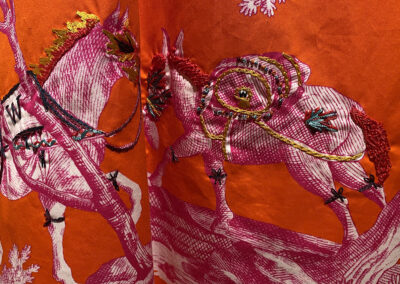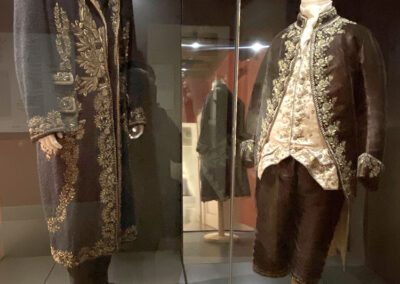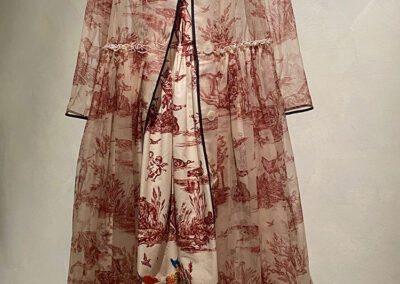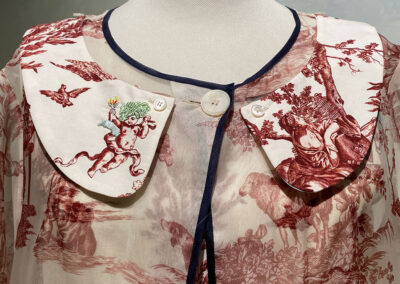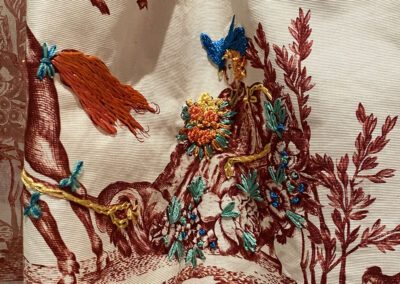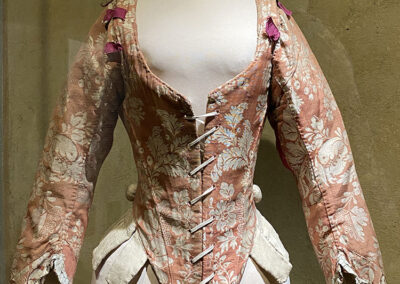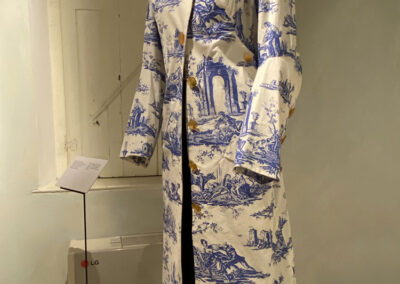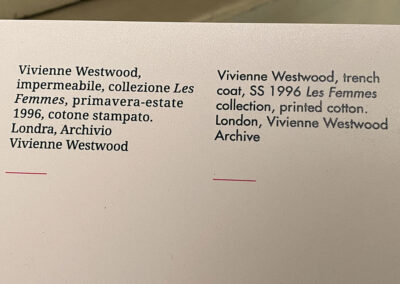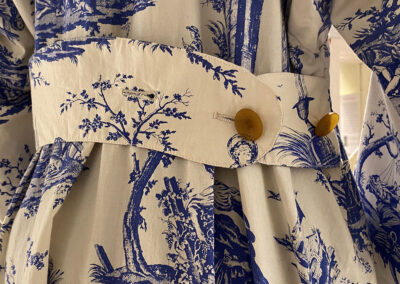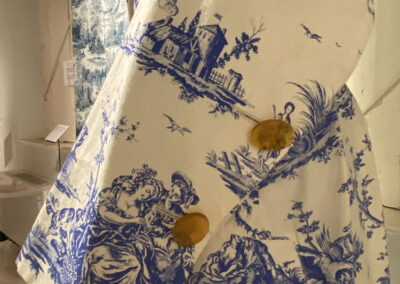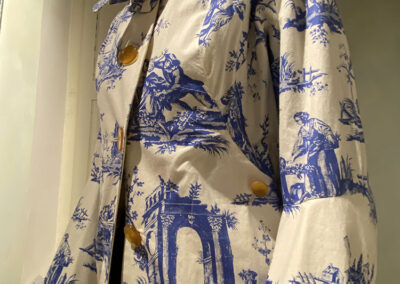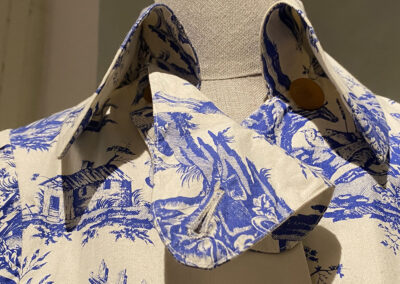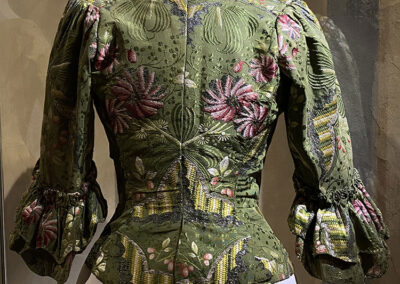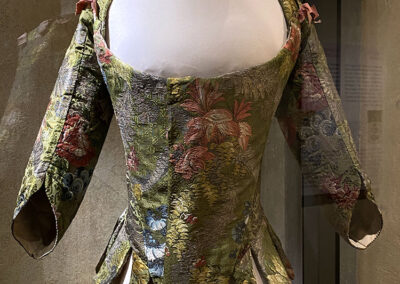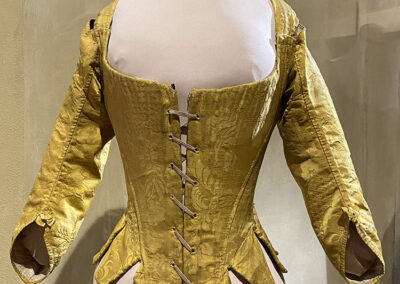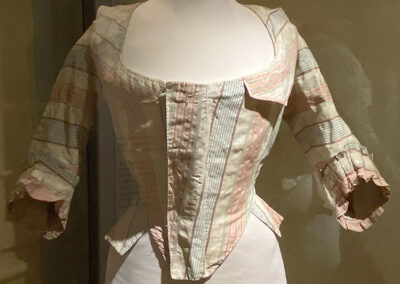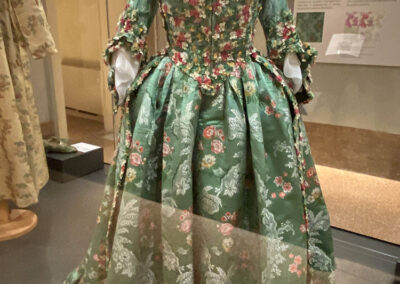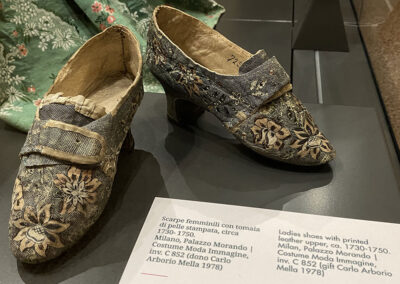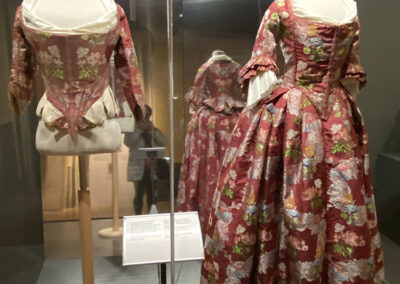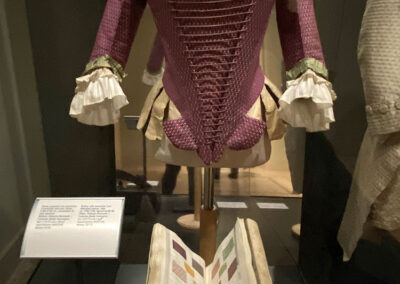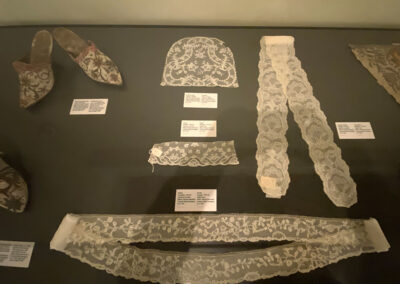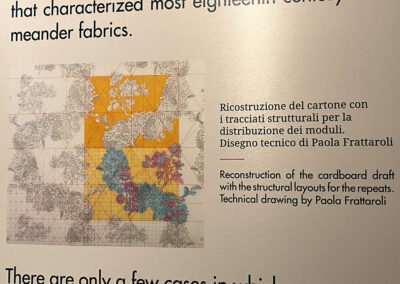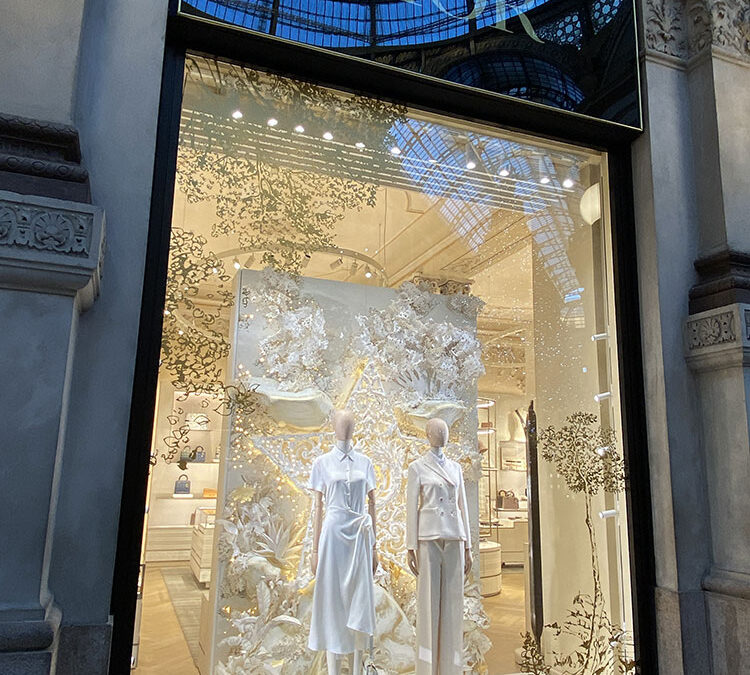
by Maureen | Jan 20, 2022 | Blog, Design, Featured Articles, Italy, Milano
Milan – one of the fashion capitals of the world – has some knock-out, incredible, no-concept-or-cost-barred window displays! Walk along Via Monte Napoleone and Via della Spiga, the posh shopping streets, (especially during the holiday shopping season) and you will see imaginative, over-stated, grand, illuminated window dressings that make it worth the walk just for the show.
Are people dressing like this on the streets? No, they’re not. In the winter months, I see a LOT of fur coats, puffy down jackets and scarves on women and men, both.
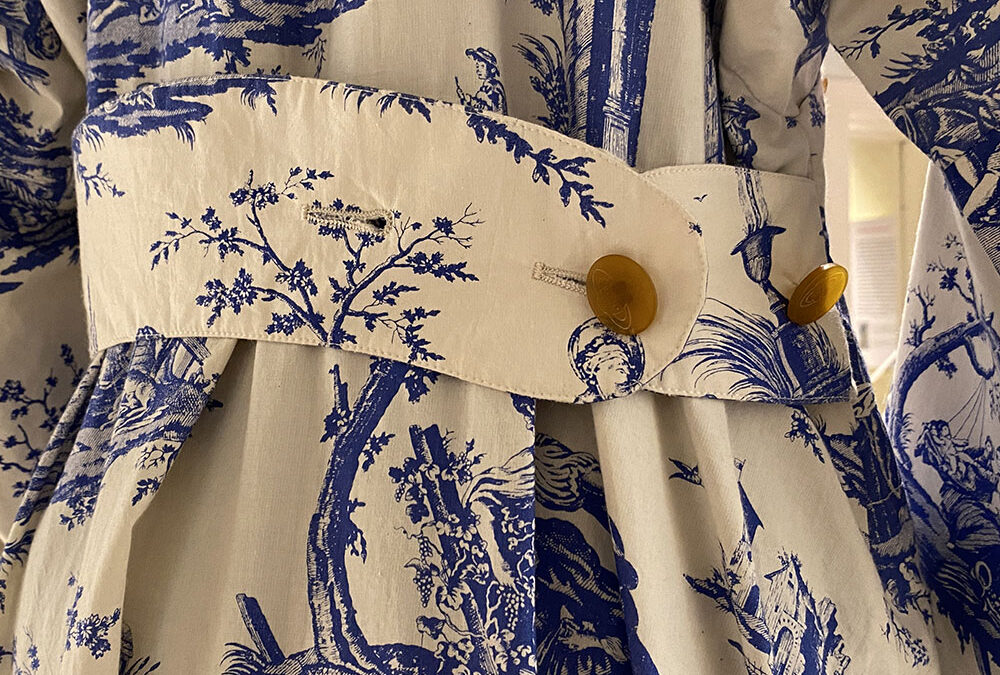
by Maureen | Jan 11, 2022 | Blog, Design, Featured Articles, Italy, Milano
In one of the fashion capitals of the world, what better sight is there to see than a show of eighteenth century clothing, and modern-day clothing it inspired. The show at Palazzo Morando is titled “Sette Cento” – literally “seven hundred”, but referring to the 1700s, thus the eighteenth century. (This is a common way of referring to the centuries, dropping reference to the first thousand years. I hear this often when speaking of antiques.)
Several of the garments had construction details that wowed me: a modified princess seam, adjustable back waist belt, detachable collar, pre-angled sleeves, uncommon gathers, over-embroidered prints. (The blue-on-white Vivienne Westwood Jacket from 1996 was particularly intriguing to me.) Seeing both the old and the new, the textiles, the details, the forms, made me itch to get in front of my sewing machine.
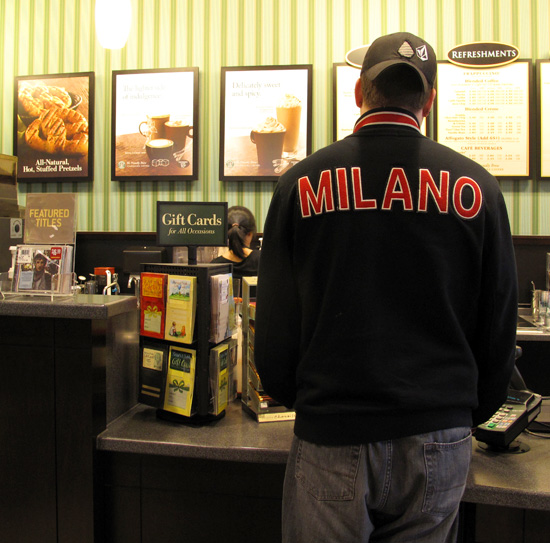
by Maureen | Feb 1, 2011 | Featured Articles, Incredible Locations, Journal, People, Photo of the Day, Photos, Quips, Seattle
While waiting to meet with a client, I stopped in a book store to browse and get a coffee. This man was in line in front of me. I smiled.
Fun to encounter little reminders of Milano and Italia and my friends and time there.

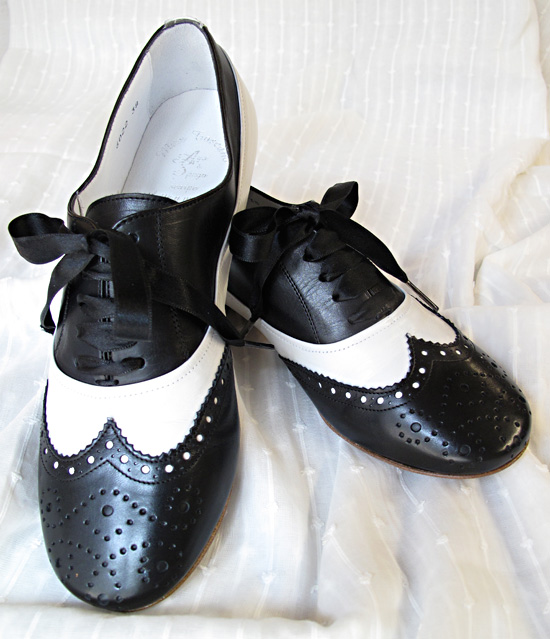
by Maureen | Jun 30, 2010 | Discoveries, Featured Articles, Introspection, Journal, Photo of the Day, Photos
“Made by Hand”.
I so love the traditional handcrafts at home in each country and culture. Over time there are those things that have developed that are either functional, decorative or both, and are crafted of fabric, paper, leather, metal, stone, wood, plant matter…
They begin with the hand and the mind of their maker, and usually reveal both. It’s a particular pleasure for me when the touch of the maker shows in the stitch, the edge, the union. Those details allow me to reach back to that person, however long ago, and sense the working of the hands.
The “classics” often spring from these traditional handcrafts and are elevated through their ties to those handcrafts. They have an extra layer of specialness and are much more than whim. They harken to history.
Italy: Among other things, leather goods. I’m not a “handbag person” so, although I’ve remarked to myself on the design, beauty and craftsmanship I’ve seen from the street market bag vendors, I haven’t been tempted. But I wanted to bring home some tidbit of Italian leather work as a nod to my time here…
Handmade wingtip shoes. I’ve had my eye on these for months as I’ve walked by the 8 foot wide storefront whenever I’ve done my shopping. Yesterday I actually tried them on. And they fit. And they came home with me with their satin ribbon ties!

I both marvel and am amused. Black-and-white pattern (which in Italy they say in reverse order as bianco-e-nero, white-and-black) is a perennial draw for me. The shoes are simple and classic. Timeless. And made by hand in the town of Vigevano, to the west of Milan. I’ve added a little train trip to my list of places to see before I leave. How I’d love to talk to the people making these shoes!
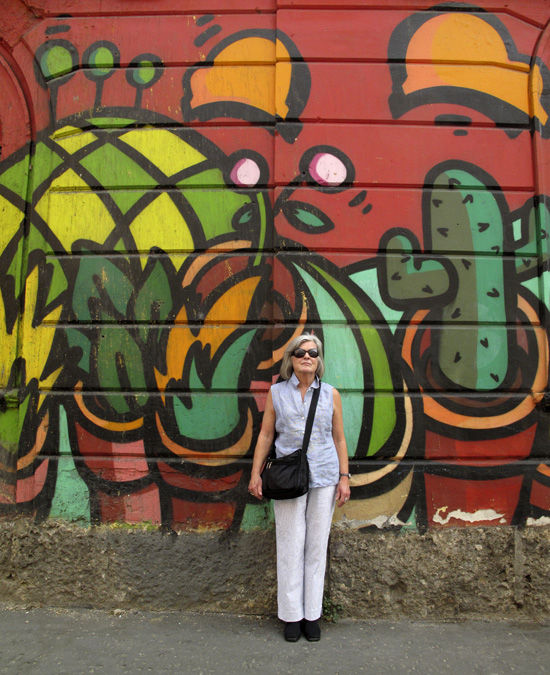
by Maureen | Jun 13, 2010 | Apartment, Church, Food!, Journal, Meals, People, Photos, Shopping & Markets
Sally flew over from Seattle a week ago to share the sights of Milano, the wonderful food treats available and the simple efficiency of my apartment. She came off the plane and out of customs beaming.
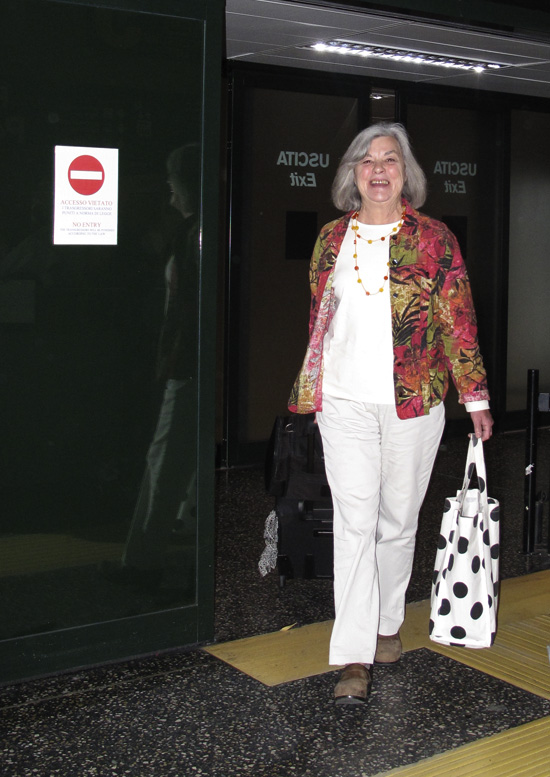
We took the Malpensa Express train from the airport into town, and got out at the Cadorna station. We walked out in front so she could see the “Needle, Thread and Knot” sculpture by Claes Oldenburg and Coosje van Bruggen. The knot is across the street, as if the needle had taken a stitch under the roadway.
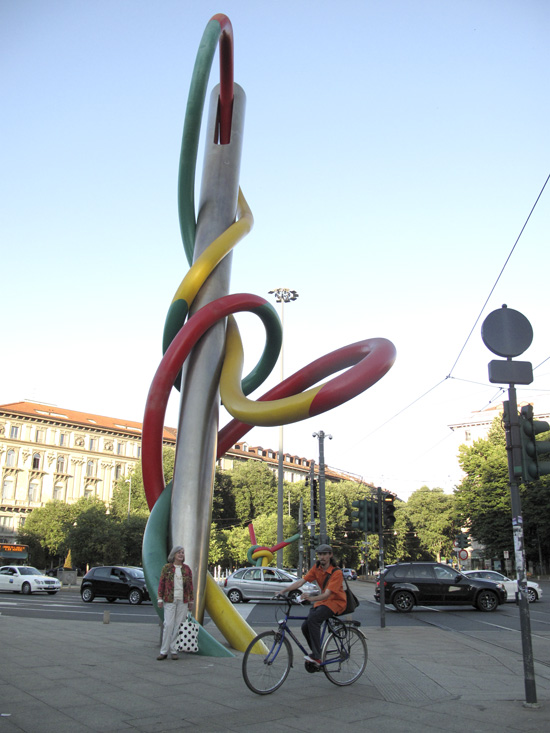
Our first breakfast was a caprese salad with mozzarella from the farm, lovely ripe tomatos, just-picked basil, served on a bed of songino – watercress – and some freshly sliced proscuitto. Not a bad welcome to Milano!
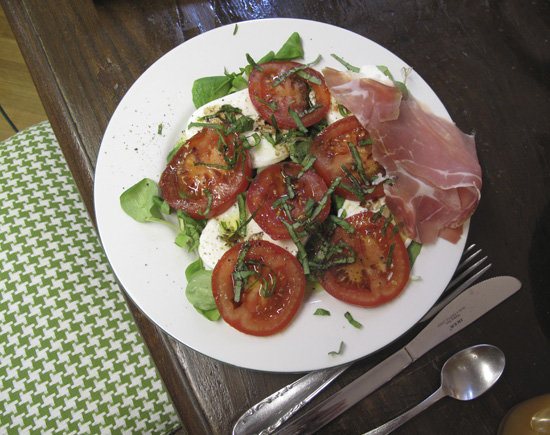
On Sally’s first day in Milano, we walked over to the Saturday street market where the vendors were selling fruit, vegetables, cheese, meat, fish, clothes and a few household goods. We stocked our kitchen with fresh basil, red pepper, asparagus, spicy salame with fennel, fresh eggs, cherry tomatoes, blood oranges, pickled onions, both “sweet” and spicy olives, burratina cheese, smoked mozzarella, dried figs from Calabria, prosciutto and bresaola.
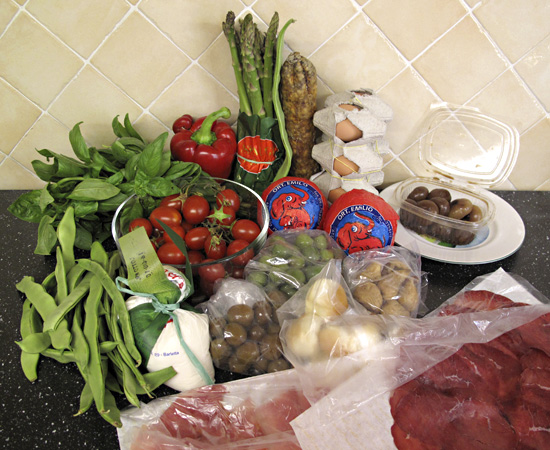
With hot weather, we opened the french doors and sat on my “shelf”, as Sally called it. Not quite big enough to be called a deck, or veranda, or lanai, it held our two chairs while we put our feet up on the railing. We chatted in the sun and greeted neighbors as they walked past to go dump their garbage in the room below us.
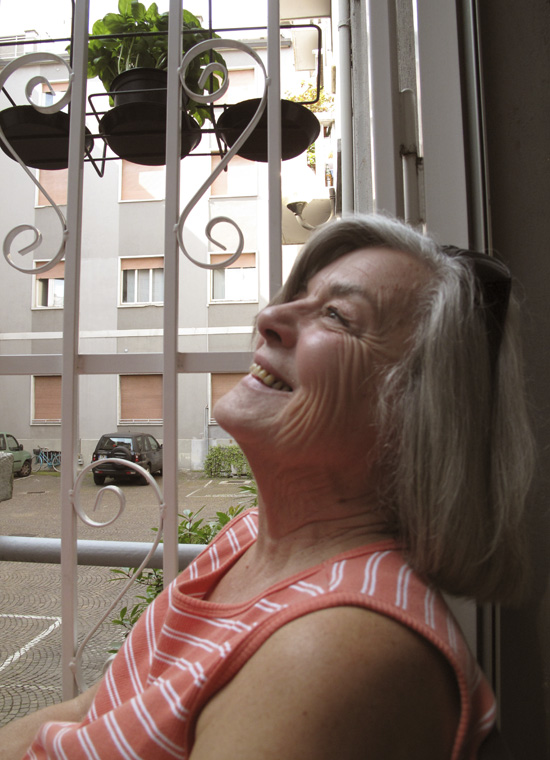
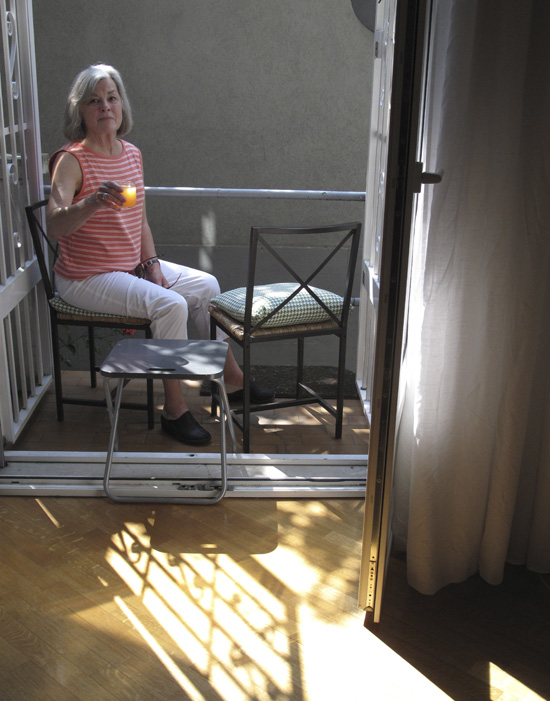
No trip to Milano would be complete without going out for aperitivi. We walked along the Naviglio Pavese Canal and stopped into one of the many restaurants that were hopping and lively on the hot, muggy night. We selected from their buffet of pasta, cheese, meats, pizza squares… and ribs (of all things). Sally’s martini was oddly sweet and not at all martini-like.
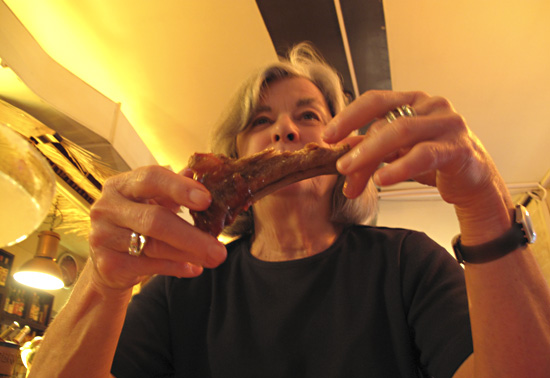
Sally enjoyed online communications, keeping in touch with family through Skype and e-mail.
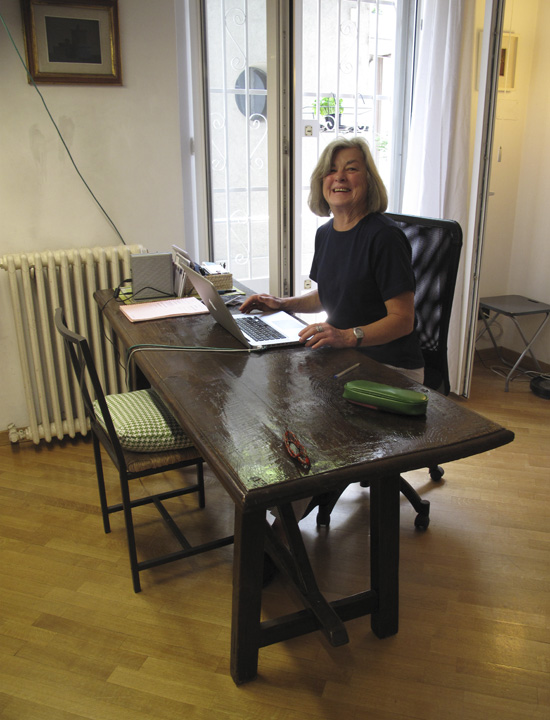
There’s a wonderful graffiti wall outside of a garden center between Corso Como and the Monumental Cemetery. What a great backdrop! This is one of my favorite photos of Sally in Milano.

We just had to take a stroll through 10 Corso Como, the city’s legendary fashion, accessories, art and design boutique. This is NOT the place to pull out your credit card, but rather just harvest ideas for garment design and construction.
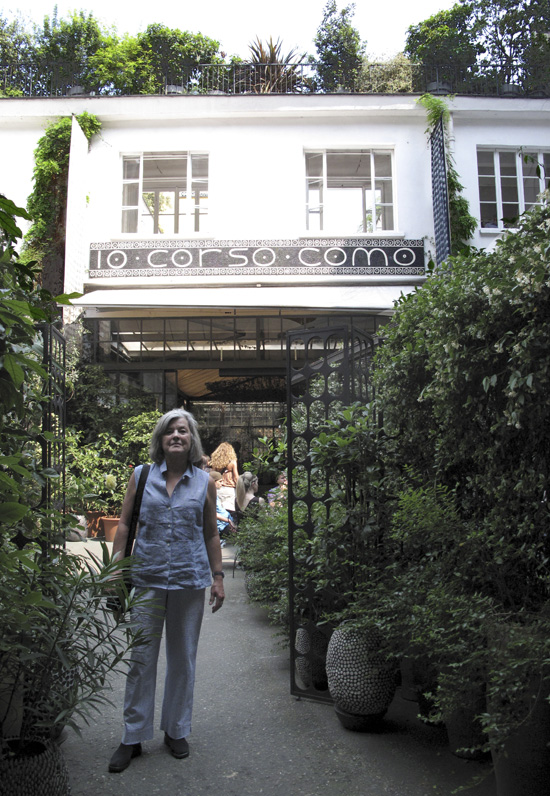
We made reservations for dinner on Saturday at Malavoglia where you ring the doorbell to get in and are greeted by bow-tie-adorned owner, Aldo, and a complementary glass of bubbly prosecco. We shared a primo of fresh pasta with black squid ink sauce. It was delicious.
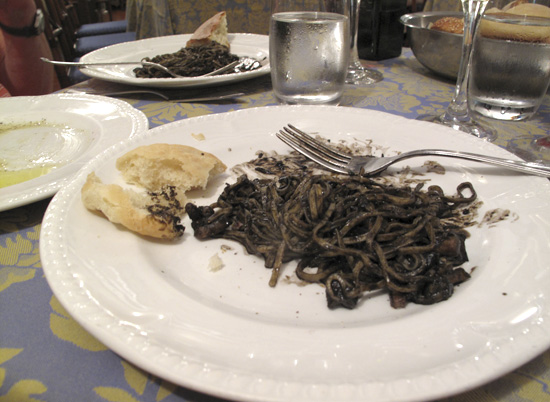
One of the highlights of Sally’s time in Milano was her visit to the Duomo. We spent time in the piazza, “the living room of the city”. We walked its circumference marveling at the variation in details and gloried at the cathedral’s interior. We topped off the tour with time on the rooftop, getting up close to the sculptures, finials and gargoyles, and looking out over the city.
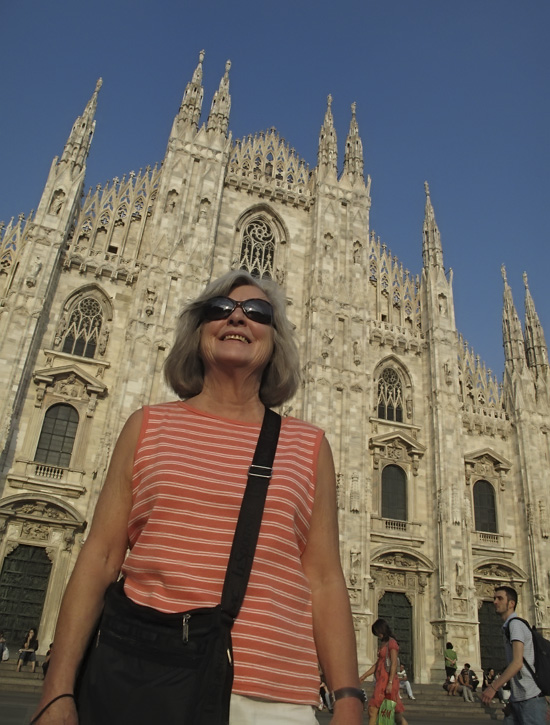
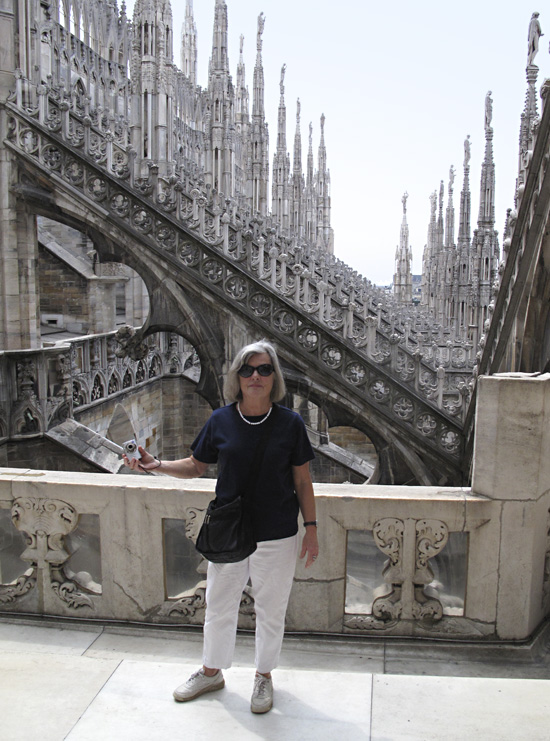
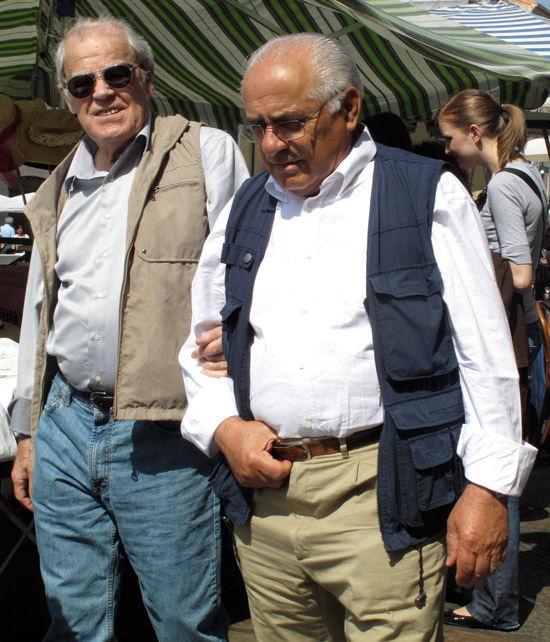
by Maureen | Jun 1, 2010 | Canals, Discoveries, Featured Articles, Introspection, Journal, People, Photo of the Day, Photos
Two “fashion” trends persist for men around here: orange-colored pants and the Milanese “man purse”, a sleeker, chic-er version of the multi-pocketed, safari vest. U.S. travel outfitters sell them as “travel vests”, but here in Milano, they are daily wear for the 60-80 set. Now that winter has gone, these functional garments have come out of the closets to populate the streets.

Yes, the term “man purse” has been used to describe the over-the-shoulder messenger bag and all its variations in which men carry cell phones, keys, PDAs, cameras, laptops, chargers, files, books and everything else they’re tethered to for the day. But man-purse-as-vest distributes the load, leaving men hands-free yet porting all of their necessaries.
As seen around Milano, the man purse vest comes in many colors, in both light and heavy weight fabrics, with zippered, buttoned or snapped pockets. They are either bulky or streamline, pared-down-basic or over-pocketed.
Along the Naviglio Grande on Sunday, after a long day at the antiques market, I stepped into an osteria for a bite to eat. I perched at a window table and set my camera for stealth photography of the steady parade of men in vests. It was a concentrated show of vest styles and their wearers. These surreptitious photos joined those that I began shooting last summer.
Who started this trend? When, where and how did this begin? Does it extend throughout Italy, or only here in the north? Will it go away any time soon? (Doubtful.)
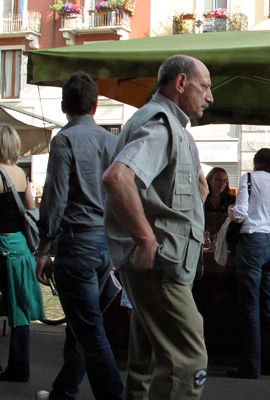
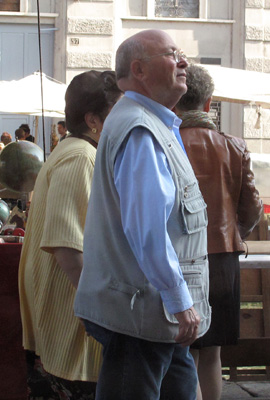
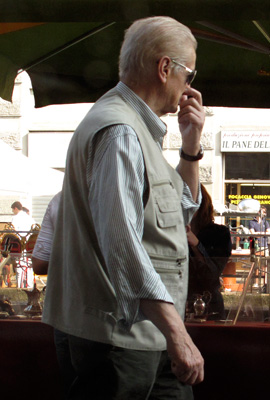
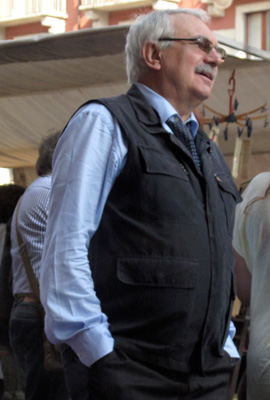
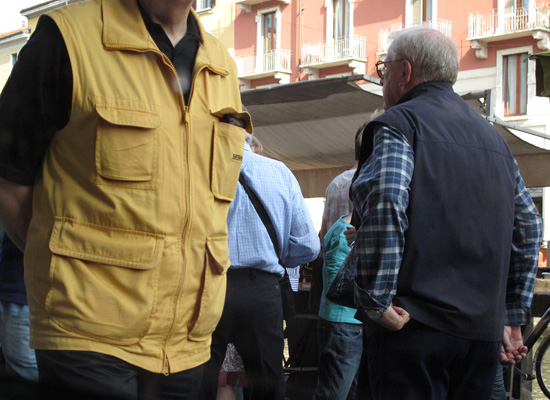
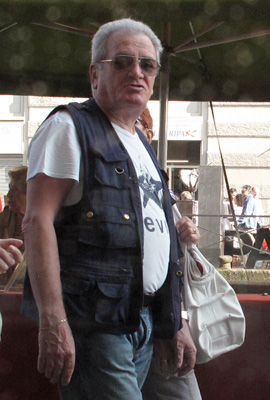
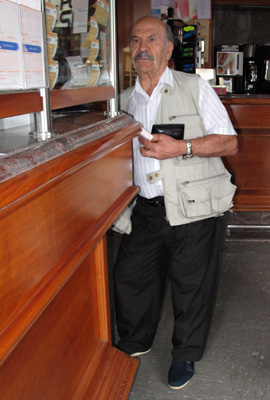
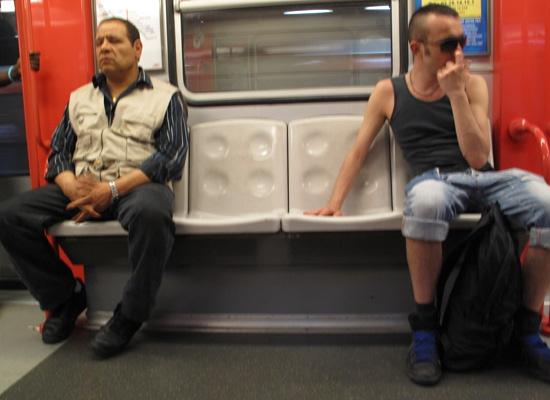
Double jackpot! Man Purse plus orange (or yellow) pants! Yes!
(I’d like to see the yellow vest with the orange pants.)
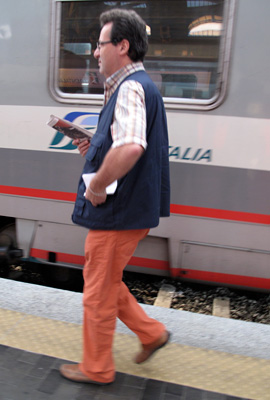
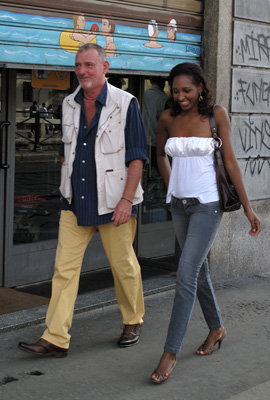
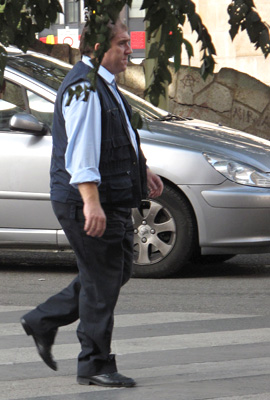
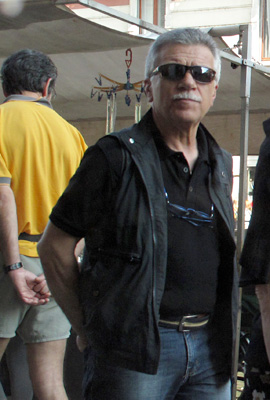
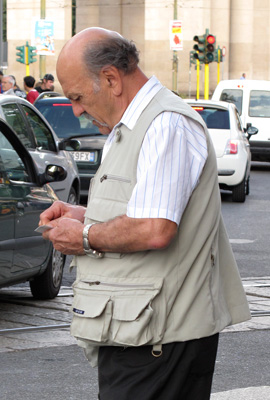
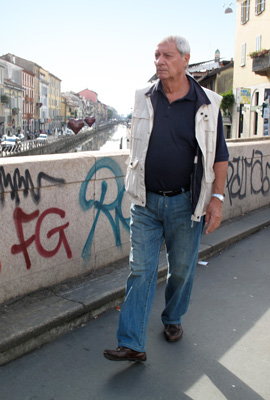
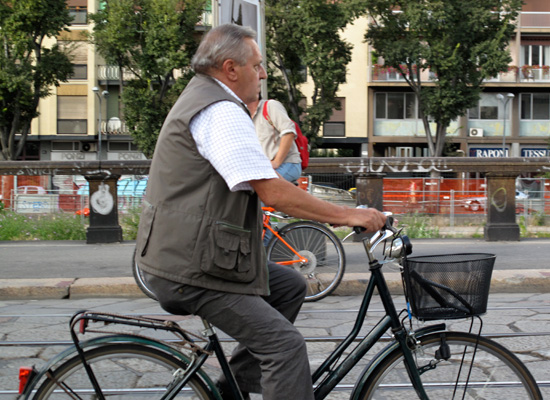
by Maureen | May 22, 2010 | Incredible Locations, Introspection, Journal, Quips, Seattle
Seattleites wear fleece, gore-tex, lycra and denim. Their fashion sense is inspired by the sporty, athletic look, whether or not they’re either sporty or athletic. Some are so casual as to be sloppy.
The Milanese wear cotton, linen, silk and wool. Denim seems reserved for the colder, winter months. More women wear skirts and dresses, and more men wear suits than I ever see in Seattle. The look is lean and trim…and sexy.
Is it a matter of level of formality? Fashion awareness? Traditional mores? What drives such visible stylistic trends?
Of course these are generalizations and certainly there are a hundred other directions seen in both places. But to have just been in Seattle for two weeks, able to observe with fresh eyes, the differences are remarkable.
by Maureen | Apr 10, 2010 | Discoveries, Food!, Introspection, Journal, Shopping & Markets
THIS is the time to be in Milano. The temperature is warm enough (75 degrees) to be comfortable in light linen and cotton, and enjoyable having the windows open to fresh air, but not so warm that there’s any thought yet of air conditioning.
I had a wandering, leisurely ride through the farmland exploring roads I hadn’t tried before. Then I showered, changed and took off walking up along Corso San Gottardo. When I need a variety of miscellanea, this is the local area I frequent.
Last September, my local Bartell’s hadn’t given me enough of a thyroid medication. It’s a pretty simple and standard thing, but necessary. I needed to buy a month’s supply and expected the process to be complicated. (International prescription refill?!) I took the bottles into a local Farmacia, they looked up the chemical component of my prescription online and walked over to a drawer for a braille-embossed box of 50 pills for 2.90 euro, about $3.90. (Hmm. At that price, maybe I should stock up before I return to Seattle? Isn’t it about $33 for a month’s supply back at home?)
There’s also this notion in my head about buying some “cool” eyeglasses to take home as my “souvenir”…Glasses that you’d never find in the U.S.…Glasses that say “somewhere else”. On San Gottardo, I stepped into a centro ottico – optic center – that I had been in before. After looking around for a while, the man that owns the shop said that he remembered me. He wasn’t just flirting. He recalled the glasses I brought in two years ago when the little screw had fallen out of the hinge. In the summer of 2008 he had replaced that little screw at no charge, and simply gave me the glasses back with a smile. (To be here in a foreign country, a big city, and be remembered from two years previous…Remarkable and touching!)
There’s something about the Italians and lingerie and hosiery. They do them well. With the warmer weather, I wanted some lightweight, little socks, just enough to provide a lining, but also interesting enough with lace and fishnet and other fun patterns. I’ve scoured shops in the Seattle area and just don’t find the selection there. (Yeah. In Seattle we’re usually bundling up, not going lightweight.) I bought several pairs of socks and hose (and will have to consider stocking up on those, too, before returning to Seattle!)
The whole street was filled with people walking their kids, their dogs and their lovers. People were seated and sipping caffé, vino or Campari. It was the time of the passeggiata, the evening stroll, and the weather had offered up a time so conducive to the ritual.
As I walked back home, I stopped at the little corner bakery that has my favorite trancio pizza – pizza that is cut to the size you want and charged by weight – and bought a piece with prosciutto, mushrooms and artichokes.
Across the street, at the corner flower vendor, I selected one fragrant lily stem and carried it toward home.
(What can’t I find along San Gottardo?!)
Veering off of Gottardo, and just blocks away from home, I saw my favorite, local bartender, Robbie, in the window of the Mayflower Pub and stopped to say “hello” and give him that European two-cheek kiss. We chatted for a moment. (“Favorite Bartender”? It sounds like I’m at the bar all the time. Actually, very rarely. But both NABA and Scuola Leonardo Language School have their student social nights there so I’ve seen Robbie enough to stop and say hello. He’s a sweet guy.)
I floated the rest of the way home. At almost ten months, I actually know people here, and am recognized by people here. I can wave at people as I walk past their shop windows or they stop me on the sidewalk to talk.
This is an indescribable and stunning time… I marvel at it all.
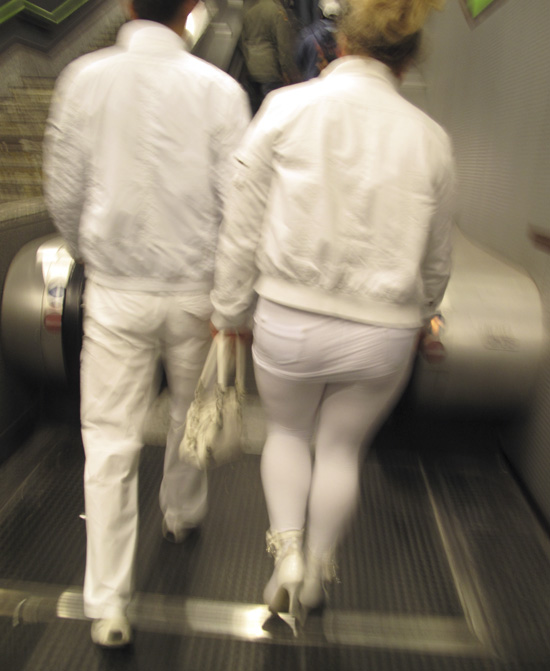
by Maureen | Mar 28, 2010 | Discoveries, Journal, People, Photos
As I was returning home from Firenze and taking the metro from the train station, this couple was practically “doing the one-two” on the subway! That’s quite a git-up they’ve got going there. (No. They are NOT typical, which made them all the more unbelievably laughable.) They sat across from me and I just couldn’t bring myself to get my camera out at such close range. But the backside view tells enough of the story for you to get the idea.

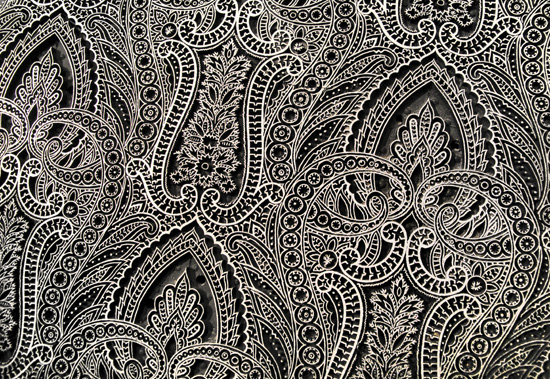
by Maureen | Mar 17, 2010 | Discoveries, Featured Articles, Graphics, Journal, Photo of the Day, Photos
When here in Milano in the summer of 2008, I stumbled upon a Zucchi Store just a half block north of the Duomo. They sell lovely household linens (sheets and towels) and they had a curious display in the window. I didn’t understand what I was seeing, so I had to go in.
Emerging up through a very large, circular hole in the first floor was a towering stack of flat wooden blocks. What were the blocks? It was then that I found out about the Zucchi Collection of wood-and-pewter blocks for printing fabric.
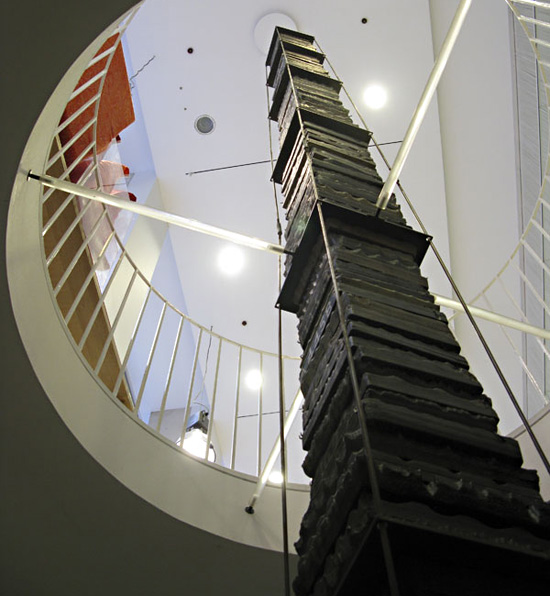
From the Zucchi Website: “The Collection’s 12,000 designs bear witness, over a period which spans three centuries from 1785 to 1935, to a fashion that was both varied and popular. Such tastes were apparent during one of the most energetic and fertile periods of European culture, which ended with the first stylistic experiments of the Art Nouveau and Art Deco movements.
“The Collection houses 56,000 printing blocks, an extraordinary number by any reckoning and one which presents concrete problems not only of space but also of storage in structures able to support the weight of many tonnes. The Collection is housed in three different storage locations: the Zucchi office in Casorezzo, the Via Foscolo location in Milan and a warehouse in Ossona.
“To make the Collection accessible not only to scholars but also to the fashion people, it was necessary to choose criteria by which the artefacts could be subdivided. The Zucchi Collection has been divided into six categories, which are identified in terms of iconographic forms: abstract, cashmere, floral, geometric, ornamental and pictorial. The Collection has been further subdivided according to the specific uses not only for the borders of the materials but also for foulards, bandanas, various ties, scarves and cravats, etc. A special data card, in computerised and paper formats, has been assigned to every series of blocks. Each of these contains various items of information about the handblock concerned, including the number of pieces which make up the structure, the design style it is capable of reproducing, its historical period and its origins. Attention has also been given to the question of conserving these structures and rightly so because the wood is sensitive material. The humidity and temperature levels require strict control and beeswax and turpentine must be applied to maintain the elasticity of the wood.”
A mere fraction of the collection has been on display on the lower floor of the Zucchi Store, including floor-to-ceiling, wall-to-wall shelves holding the numbered wood blocks. (They are now in the process of moving these blocks to another location.) Note that some designs have 3-5 different blocks to create the full design. (They are all numbered alike.) Being a lover of textiles I was immediately enamored of the collection.
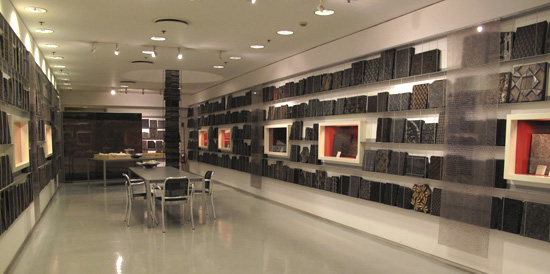
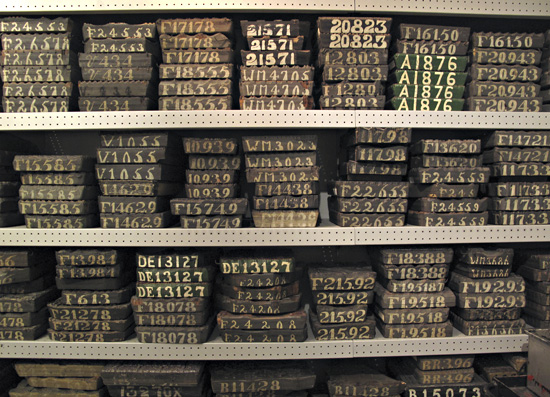
Fast-forward almost 2 years and now I’m living in Milano. Last Fall I found a curious and creative textile studio not far away named “L’Hub” on the Naviglio Grande, the “big” canal. One, they were selling vintage Zucchi linen and cotton dishtowels from the mid- and late-1900s. (Yes. I bought a bunch.) Two, they offer all sorts of creative textile classes including dyeing, sewing, construction, AND printing fabric with the centuries-old Zucchi blocks! Can you say “Sign me up!”?
I enrolled in the 3-hour class held last Saturday afternoon, taught by artist Franco Duranti (at the very far left in the next photo). Among other things, Franco is a painter, engraver, and video artist AND since 2007, he’s been creating original works with the Zucchi wood blocks! Below is a photo of the working studio at L’Hub. Some women were taking a sewing class, while two other women were also taking the fabric stamping class.
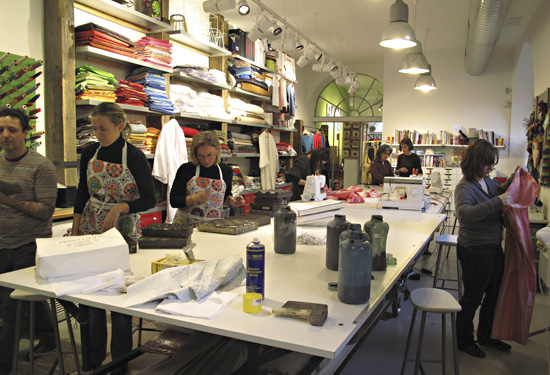
I wanted “classic”. I had just seen the Frette Textile Exhibit a week ago. I’m enthralled by the traditional fabric handwork of generations past and am especially inspired by my Great Great Grandmother’s work, done at age 12 in 1861. She crafted a cross-stitch sampler in “Turkey Red” on cream-colored cloth, and that color combination has launched me ever since my Grandmother gave me the sampler in 1975.
On the neighboring streets (on that recent day when I was getting snowflakes in my eyes) I scouted fabric stores and came away with Italian, 100% Linen. I bought a meter of fabric and took it home to prewash.
In familiarizing myself with the printing process, I chose a simple fleur-de-lis pattern printed in “carminio” – carmine red – on the linen. Note how, in this case, the block carries an “island” of cast pewter attached to the wood,
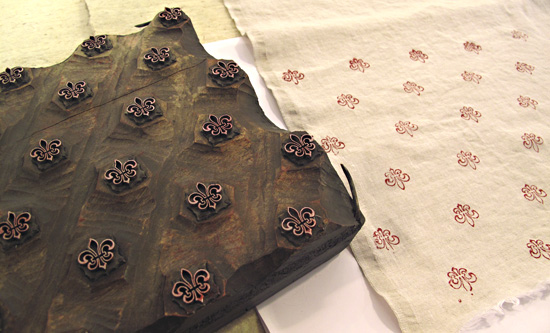
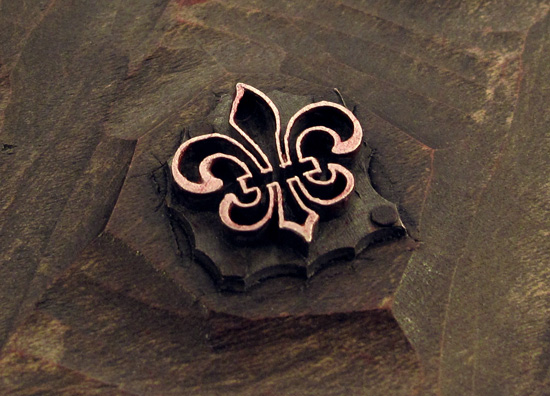
The following is an intricate, cast-pewter, paisley design from the “Cashmere” group of blocks in the collection. THIS makes my heart melt! Unfortunately, I was not able to print with this block, but printed with one I found that was as close as possible.

In gathering fabric for printing, I had also gone BACK to the Zucchi store downtown and they just happened to be having a sale! I bought two sets of sheets. One set is 100% cotton, satin finish with a subtle, printed khaki/cream pattern. I printed right over the top of the pattern to create a set of sheets like no other in the world.
I also paid a visit to the second-hand store 2 blocks away. I found white, cotton button-end pillowcases and bought all six at 2 euro each (about $2.75) When I got them home to wash them, I looked inside and noticed a… Zucchi label! Of course.
My plan now is to return to the L’Hub studio for a solo 3-hour stint to embellish the pieces I began, and to print even more.
As I wallow in Art and Design during my time here in Italy, I can’t imagine a more exhilarating addition to my list of design experiences than printing with the Zucchi handblocks at L’Hub!
